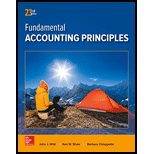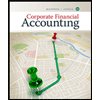
Fundamental Accounting Principles
23rd Edition
ISBN: 9781259536359
Author: John J Wild, Ken Shaw Accounting Professor, Barbara Chiappetta Fundamental Accounting Principles
Publisher: McGraw-Hill Education
expand_more
expand_more
format_list_bulleted
Concept explainers
Textbook Question
Chapter 6, Problem 1E
Exercise 6.1
Inventory ownership
I. At rear-end, Harris Co. had shipped $12,500 of merchandise FOB destination to Harlow Co. Which company should include the $12,500 of merchandise in transit as part of its rear-end inventory?
2. Harris Company has shipped $20,000 of goods to Harlow Co., and Harlow Co. has arranged to sell the goods for Harris. Identify the consignor and the consignee. Which company should include any unsold goods as part of its inventory?
Expert Solution & Answer
Want to see the full answer?
Check out a sample textbook solution
Students have asked these similar questions
Financial Accounting
Can you solve this general accounting problem with appropriate steps and explanations?
I need the correct answer to this general accounting problem using the standard accounting approach.
Chapter 6 Solutions
Fundamental Accounting Principles
Ch. 6 - Prob. 1DQCh. 6 - 2. Where is the amount of merchandise inventory...Ch. 6 - Prob. 3DQCh. 6 - Prob. 4DQCh. 6 - What does the full disclosure principle prescribe...Ch. 6 - Prob. 6DQCh. 6 - Prob. 7DQCh. 6 - Prob. 8DQCh. 6 - Prob. 9DQCh. 6 - What is the meaning of market as it is used in...
Ch. 6 - Prob. 11DQCh. 6 - Prob. 12DQCh. 6 - Prob. 13DQCh. 6 - Prob. 14DQCh. 6 - Prob. 15DQCh. 6 - Prob. 16DQCh. 6 - Prob. 17DQCh. 6 - Prob. 1QSCh. 6 - Prob. 2QSCh. 6 - Prob. 3QSCh. 6 - Prob. 4QSCh. 6 - Prob. 5QSCh. 6 - QS 64
Perpetual Inventory costing with weighted...Ch. 6 - Periodic: Inventory costing with FIFO P3 Refer to...Ch. 6 - Prob. 8AQSCh. 6 - Prob. 9AQSCh. 6 - Prob. 10QSCh. 6 - Prob. 11QSCh. 6 - Prob. 12QSCh. 6 - Prob. 13QSCh. 6 - Prob. 14AQSCh. 6 - Prob. 15AQSCh. 6 - Prob. 16AQSCh. 6 - Prob. 17AQSCh. 6 - Prob. 18QSCh. 6 - Prob. 19QSCh. 6 - Prob. 20QSCh. 6 - Prob. 21QSCh. 6 - Prob. 22BQSCh. 6 - International accounting standards C2 P2 Answer...Ch. 6 - Exercise 6.1 Inventory ownership I. At rear-end,...Ch. 6 - Exercise 6-2 Inventory costs C2 Walberg...Ch. 6 - Prob. 3ECh. 6 - Prob. 4ECh. 6 - Prob. 5AECh. 6 - Exercise 6-6A Periodic: Income effects of...Ch. 6 - Prob. 7ECh. 6 - Prob. 8ECh. 6 - Prob. 9AECh. 6 - Prob. 10ECh. 6 - Prob. 11ECh. 6 - Prob. 12ECh. 6 - Prob. 13ECh. 6 - Prob. 14AECh. 6 - Prob. 15AECh. 6 - Prob. 16BECh. 6 - Prob. 17BECh. 6 - Prob. 18ECh. 6 - Prob. 1APSACh. 6 - Prob. 2AAPSACh. 6 - Prob. 3APSACh. 6 - Prob. 4AAPSACh. 6 - Prob. 5APSACh. 6 - Prob. 6APSACh. 6 - Prob. 7AAPSACh. 6 - Prob. 8AAPSACh. 6 - Prob. 9ABPSACh. 6 - Prob. 10ABPSACh. 6 - Prob. 1BPSBCh. 6 - Problem 6-2BA
Periodic: Alternative cost...Ch. 6 - Prob. 3BPSBCh. 6 - Prob. 4BAPSBCh. 6 - Prob. 5BPSBCh. 6 - Prob. 6BPSBCh. 6 - Prob. 7BAPSBCh. 6 - Prob. 8BAPSBCh. 6 - Prob. 9BBPSBCh. 6 - Prob. 10BBPSBCh. 6 - Prob. 6SPCh. 6 - Prob. 1BTNCh. 6 - Prob. 2BTNCh. 6 - Prob. 3BTNCh. 6 - Prob. 4BTNCh. 6 - Prob. 5BTNCh. 6 - Prob. 6BTNCh. 6 - Review the chapter’s opening feature highlighting...Ch. 6 - Prob. 8BTNCh. 6 - Prob. 9BTN
Knowledge Booster
Learn more about
Need a deep-dive on the concept behind this application? Look no further. Learn more about this topic, accounting and related others by exploring similar questions and additional content below.Similar questions
- Can you explain this financial accounting question using accurate calculation methods?arrow_forwardI am trying to find the accurate solution to this general accounting problem with the correct explanation.arrow_forwardHow can I solve this financial accounting problem using the appropriate financial process?arrow_forward
- Can you solve this general accounting question with the appropriate accounting analysis techniques?arrow_forwardI am looking for help with this financial accounting question using proper accounting standards.arrow_forwardCan you show me the correct approach to solve this financial accounting problem using suitable standards?arrow_forward
arrow_back_ios
SEE MORE QUESTIONS
arrow_forward_ios
Recommended textbooks for you
 Cornerstones of Financial AccountingAccountingISBN:9781337690881Author:Jay Rich, Jeff JonesPublisher:Cengage Learning
Cornerstones of Financial AccountingAccountingISBN:9781337690881Author:Jay Rich, Jeff JonesPublisher:Cengage Learning Financial Accounting: The Impact on Decision Make...AccountingISBN:9781305654174Author:Gary A. Porter, Curtis L. NortonPublisher:Cengage Learning
Financial Accounting: The Impact on Decision Make...AccountingISBN:9781305654174Author:Gary A. Porter, Curtis L. NortonPublisher:Cengage Learning Financial & Managerial AccountingAccountingISBN:9781337119207Author:Carl Warren, James M. Reeve, Jonathan DuchacPublisher:Cengage Learning
Financial & Managerial AccountingAccountingISBN:9781337119207Author:Carl Warren, James M. Reeve, Jonathan DuchacPublisher:Cengage Learning Corporate Financial AccountingAccountingISBN:9781305653535Author:Carl Warren, James M. Reeve, Jonathan DuchacPublisher:Cengage Learning
Corporate Financial AccountingAccountingISBN:9781305653535Author:Carl Warren, James M. Reeve, Jonathan DuchacPublisher:Cengage Learning Corporate Financial AccountingAccountingISBN:9781337398169Author:Carl Warren, Jeff JonesPublisher:Cengage Learning
Corporate Financial AccountingAccountingISBN:9781337398169Author:Carl Warren, Jeff JonesPublisher:Cengage Learning Financial & Managerial AccountingAccountingISBN:9781285866307Author:Carl Warren, James M. Reeve, Jonathan DuchacPublisher:Cengage Learning
Financial & Managerial AccountingAccountingISBN:9781285866307Author:Carl Warren, James M. Reeve, Jonathan DuchacPublisher:Cengage Learning

Cornerstones of Financial Accounting
Accounting
ISBN:9781337690881
Author:Jay Rich, Jeff Jones
Publisher:Cengage Learning

Financial Accounting: The Impact on Decision Make...
Accounting
ISBN:9781305654174
Author:Gary A. Porter, Curtis L. Norton
Publisher:Cengage Learning

Financial & Managerial Accounting
Accounting
ISBN:9781337119207
Author:Carl Warren, James M. Reeve, Jonathan Duchac
Publisher:Cengage Learning

Corporate Financial Accounting
Accounting
ISBN:9781305653535
Author:Carl Warren, James M. Reeve, Jonathan Duchac
Publisher:Cengage Learning

Corporate Financial Accounting
Accounting
ISBN:9781337398169
Author:Carl Warren, Jeff Jones
Publisher:Cengage Learning

Financial & Managerial Accounting
Accounting
ISBN:9781285866307
Author:Carl Warren, James M. Reeve, Jonathan Duchac
Publisher:Cengage Learning
The ACCOUNTING EQUATION For BEGINNERS; Author: Accounting Stuff;https://www.youtube.com/watch?v=56xscQ4viWE;License: Standard Youtube License